Technical information
Result
Products and construction methods applicable to 「Durable Pavement」
Refine further
(23 items)
-
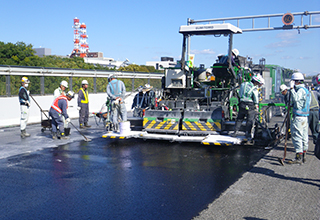
Polymer Modified Gussasphalt SMART GUSSASPHALT
Reduces odors and significantly improves fatigue resistance
This modified gussasphalt mixture delivers improved performance over conventional gussasphalt mixtures. This mixture combines excellent flow resistance and flexure-tracking properties with reduced amounts of generated odor characteristics of conventional gussasphalt.
-
Feature mark :

-
Category :
-
Paving Methods > Roadway > Bridge Surfaces / Waterproof >
-
Feature mark :
-
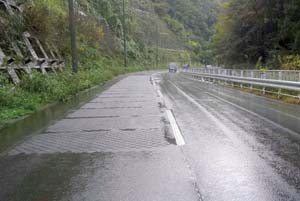
Anti-slipping Stamped Asphalt GRIPSURF
Safety is improved thanks to the lattice-like grooves incorporated into the pavement surface
This is a road traffic safety measure method that works by pressing molds into the pavement surface to incorporate lattice-like grooves into the road surface. These grooves make the pavement safer for vehicles in rainy weather and in winter.
-
Feature mark :



-
Category :
-
Paving Methods > Roadway > Traffic Safety Measures >
-
Feature mark :
-
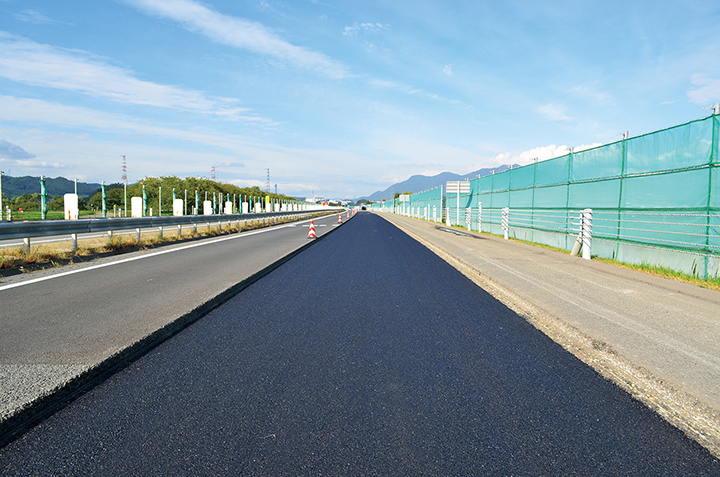
High Modullus Asphalt (EME) HIGHRIGID BASE
Hard and durable road base using a highly rigid asphalt mixture
This is a road base material which is made using a highly rigid asphalt mixture. Because the rigidity is much greater than that of ordinary road base, the load on the existing subbase is reduced, the asphalt pavement can be rendered more durable, and its service life can be extended.
-
Feature mark :


-
Category :
-
Paving Methods > Sub-grade / Base > Construction technology >
-
Feature mark :
-
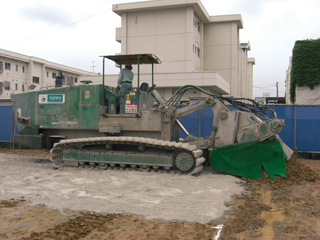
Subgrade Soil Stabilization DEEP-STABI
For strengthening the road base, improving the subgrade, and taking soft-ground measures with a treatment thickness of 30 to 100 cm
This is a construction method that stabilizes the existing subgrade soil by adding and mixing cement and lime in situ. The finished thickness of one layer is 30 to 100 cm.
-
Feature mark :



-
Category :
-
Paving Methods > Sub-grade / Base > Stabilization >
-
Feature mark :
-
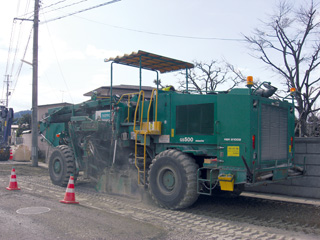
Soil Stabilization BASE-STABI
For strengthening the road base, improving the subgrade, and taking soft-ground measures with a treatment thickness of 30 cm or less
This is a construction method that stabilizes the existing road base by adding and mixing cement and lime in situ. The finished thickness of one layer is 10 to 30 cm.
-
Feature mark :



-
Category :
-
Paving Methods > Sub-grade / Base > Stabilization >
-
Feature mark :
-
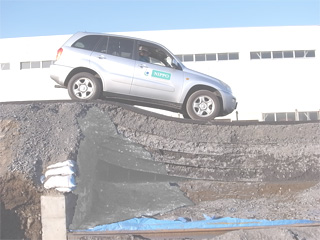
Step Preventive Pavement HRB
Prevents pavements from collapsing in an earthquake
This construction method involves building a composite rigid layer on the subgrade using a high-strength geo-grid and restraining members. It prevents the pavement from collapsing due to an earthquake and inhibits the formation of cracks and bumps in the asphalt pavement road surface. This allows emergency vehicles to travel on the road immediately after an earthquake, thereby helping to accelerate the initial response to any urgent call to save lives and transport supplies.
-
Feature mark :



-
Category :
-
Paving Methods > Roadway > Subsidence Measures >
-
Feature mark :
-
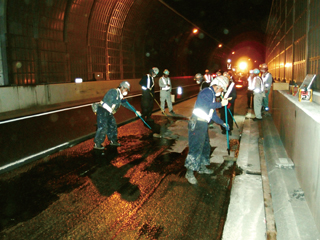
High Permeable Composite Concrete Slab Waterproofing Method HARD-FRESH
A road bridge deck waterproofing method that can be expected to have high waterproofing and reinforcement effects on the upper surface of the deck slabs.
This is the road bridge slab waterproofing method that can be expected to provide exceptional waterproofing and reinforcement effects through the combined use of a highly permeable waterproofing material that deeply penetrates into and adheres to penetrating cracks and fine cracks in concrete slabs and an asphalt-heated coating for the waterproofing material. Because application and curing times are short, this method is suitable for repairing bridge surface pavements where time constraints apply.
-
Feature mark :




-
Category :
-
Paving Methods > Roadway > Bridge Surfaces / Waterproof >
-
Feature mark :
-
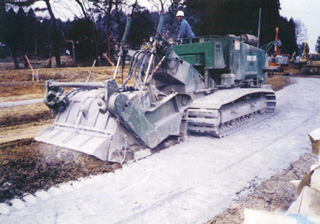
Cold In-place (In situ) Recycling FRB
Economical and environmentally friendly as it reuses existing asphalt pavement.
This is a cold-in-place recycling method in which aged asphalt pavement that has developed alligator cracks is crushed in-place and mixed with the underlying road base material while adding cement, etc. to create a new stabilized base courase.
-
Feature mark :





-
Category :
-
Paving Methods > Roadway > Maintain / Repair >
-
Feature mark :
-
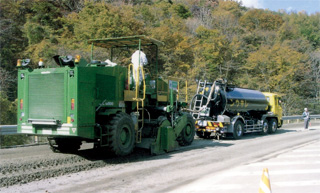
Cold in-place recycling of Consolidated Road Base SUPER FRB
Reclaiming damaged reclaimed base with "Road Recycler"
This is a cold in-place recycling method that reclaims the damaged old base courase which was firmly consolidated due to previous stabilization. The high-performance stabilizer “Road Recycler” can efficiently crush and mix such consolidated existing base courase, which is difficult to do with conventional road stabilizers.
-
Feature mark :





-
Category :
-
Paving Methods > Roadway > Maintain / Repair >
-
Feature mark :
-
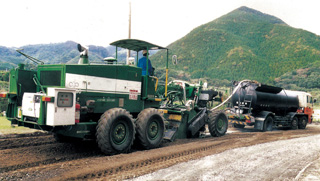
Cold in-place Recycling with Foamed Bitumen FOAMED FRB
Recycling method for promoting environmental conservation and reducing costs
This is a cold in-place recycling method that reclaims old existing asphalt and base course by mixing foamed asphalt and a small amount of cement, and reuses it as a base course for new pavement. This is a more economical pavement repair method than the in-place base recycling using asphalt emulsion or the pavement replacing.
-
Feature mark :





-
Category :
-
Paving Methods > Roadway > Maintain / Repair >
-
Feature mark :
| Common name | Product name | Overview |
|---|---|---|
| Polymer Modified Gussasphalt | SMART GUSSASPHALT | This modified gussasphalt mixture delivers improved performance over conventional gussasphalt mixtures. This mixture combines excellent flow resistance and flexure-tracking properties with reduced amounts of generated odor characteristics of conventional gussasphalt. |
| Anti-slipping Stamped Asphalt | GRIPSURF | This is a road traffic safety measure method that works by pressing molds into the pavement surface to incorporate lattice-like grooves into the road surface. These grooves make the pavement safer for vehicles in rainy weather and in winter. |
| High Modullus Asphalt (EME) | HIGHRIGID BASE | This is a road base material which is made using a highly rigid asphalt mixture. Because the rigidity is much greater than that of ordinary road base, the load on the existing subbase is reduced, the asphalt pavement can be rendered more durable, and its service life can be extended. |
| Subgrade Soil Stabilization | DEEP-STABI | This is a construction method that stabilizes the existing subgrade soil by adding and mixing cement and lime in situ. The finished thickness of one layer is 30 to 100 cm. |
| Soil Stabilization | BASE-STABI | This is a construction method that stabilizes the existing road base by adding and mixing cement and lime in situ. The finished thickness of one layer is 10 to 30 cm. |
| Step Preventive Pavement | HRB | This construction method involves building a composite rigid layer on the subgrade using a high-strength geo-grid and restraining members. It prevents the pavement from collapsing due to an earthquake and inhibits the formation of cracks and bumps in the asphalt pavement road surface. This allows emergency vehicles to travel on the road immediately after an earthquake, thereby helping to accelerate the initial response to any urgent call to save lives and transport supplies. |
| High Permeable Composite Concrete Slab Waterproofing Method | HARD-FRESH | This is the road bridge slab waterproofing method that can be expected to provide exceptional waterproofing and reinforcement effects through the combined use of a highly permeable waterproofing material that deeply penetrates into and adheres to penetrating cracks and fine cracks in concrete slabs and an asphalt-heated coating for the waterproofing material. Because application and curing times are short, this method is suitable for repairing bridge surface pavements where time constraints apply. |
| Cold In-place (In situ) Recycling | FRB | This is a cold-in-place recycling method in which aged asphalt pavement that has developed alligator cracks is crushed in-place and mixed with the underlying road base material while adding cement, etc. to create a new stabilized base courase. |
| Cold in-place recycling of Consolidated Road Base | SUPER FRB | This is a cold in-place recycling method that reclaims the damaged old base courase which was firmly consolidated due to previous stabilization. The high-performance stabilizer “Road Recycler” can efficiently crush and mix such consolidated existing base courase, which is difficult to do with conventional road stabilizers. |
| Cold in-place Recycling with Foamed Bitumen | FOAMED FRB | This is a cold in-place recycling method that reclaims old existing asphalt and base course by mixing foamed asphalt and a small amount of cement, and reuses it as a base course for new pavement. This is a more economical pavement repair method than the in-place base recycling using asphalt emulsion or the pavement replacing. |
(23 items)
